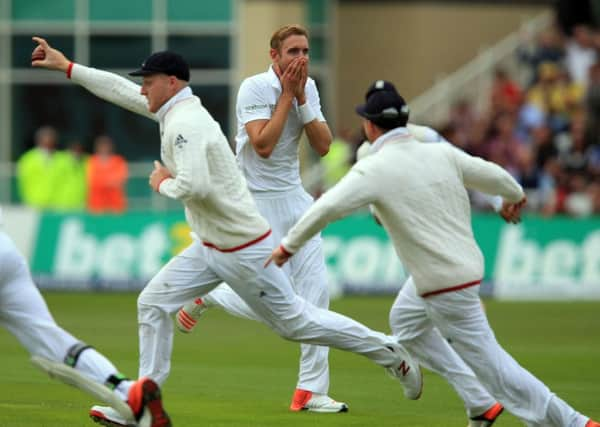Grant Woodward: Are we sure they’re playing Test cricket?


It began with the visiting New Zealanders crash, bang, walloping their way through a rollicking two-match series and taking the home team along for the ride. The dust settled with honours even, the public more than a little punch-drunk and England pledging to embrace this new, T20-inspired brand of ‘positive cricket’.
But as thrilling as those games were, we veteran cricket watchers told ourselves this was merely the knockabout stuff before the Australians touched down and the serious business of the Ashes got under way.
Advertisement
Hide AdAdvertisement
Hide AdThe battle for the most famous trophy in sport would surely demand a slightly more sober approach, one that saw a return to the measured, don’t-budge-an-inch mindset that has characterised cricket down the ages. Wouldn’t it?
Well, no, actually. Yesterday’s third Test at Trent Bridge may have begun with the destiny of the battered brown urn (or at least its replica) still in doubt, but within the space of an extraordinary 111 balls the Australian first innings had been completed and England were batting – all before a single spectator’s sandwich had been unwrapped in anger.
In the good old days, Yorkshire’s own Geoff Boycott would have still been getting his eye in. Instead the game was already a quarter finished.
Anyone with tickets for day three, let alone days four or five, immediately began making alternative plans. It has been that kind of summer, with both batting line-ups looking capable of self-combustion at the drop of a hat – or, in this case, a toss of Alastair Cook’s trusty £2 coin.
Advertisement
Hide AdAdvertisement
Hide AdAs thrilling as this regular tumbling of wickets is, however, I can’t help feeling that my world has been turned upside down. After all, I am old enough to recall the days when 250 was considered a par score in a limited overs game but distinctly not up to snuff in the five-day format, the original and truest litmus test of the planet’s cricketing powers.
Now it seems to be the other way round, with teams (even England, for heaven’s sake) routinely racking up 400-plus totals in 50-over bashes and then winning Tests with skittish innings that fail to even scrape past 300. As the late, legendary Fred Trueman once opined, I just don’t know what’s going off out there.
Such is the helter skelter pace of the matches these days that the draw has been rendered an overnight anachronism, unless the weather gets involved.
No wonder the England and Wales Cricket Board suggested at the start of this year that the five-day Test match should be consigned to the record books, four days being more than enough for modern teams to batter each other to the canvas.
Advertisement
Hide AdAdvertisement
Hide AdThey may well be right, but if that does come to pass a part of me will mourn the death of the game I grew up with. Nowadays players seem to consider it their right to take a wicket or cover drive a flashing four with every ball. What happened to the nuance and subtlety that made cricket a field-based form of chess, with added breaks for light refreshments?
There was a seductive quality to the labyrinthine unfolding of a traditional Test match. The small moments of drama that built into the crescendo of a wicket or boundary – a slight field change perhaps, or a gradual build-up of pressure which could only be released with the clout of willow or clatter of stumps.
Subtle shifts that were all but imperceptible to the untrained eye but constituted the very essence of cricket, lending it a uniquely mesmeric quality that demanded the closest of attention, even when nothing much appeared to be happening.
To grasp the beauty of this understated drama was to become a member of the club, someone whose eyes had been opened to the wonders of a game that, after five days of punch and counter-punch, could still end in a draw. We saw the skill, courage and, yes, artistry, in the gritty, unbeaten 38 when the ball is moving sideways and the odds on survival are slim.
Advertisement
Hide AdAdvertisement
Hide AdAs gratifying as a reclaiming of the Ashes would be, we die-hards can’t help but rue the fact that all the foreplay has been stripped from today’s game, which merely serves up the same instant gratification that has come to pervade every other corner of 21st century society.
One of the greatest Test match innings I have ever witnessed was Michael Atherton’s 11-hour 185 not out to save England from defeat at Johannesburg in 1995. It was like Rorke’s Drift sponsored by Gray Nicolls.
This summer, with England having to survive the best part of two days to rescue a draw at Lord’s, Atherton was invited to share his memories of that rearguard action in a bid to inspire a similar response. The England players listened intently – and were bowled out for 103.
It was proof that the gift of graft is long gone – and Test cricket is all the poorer for it.